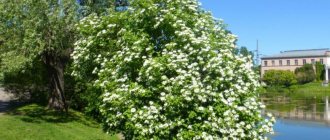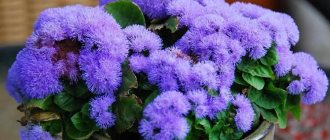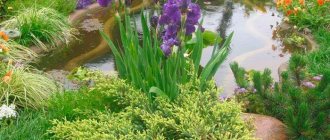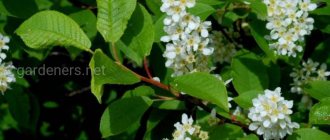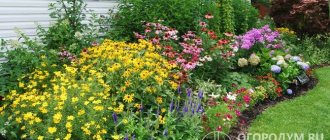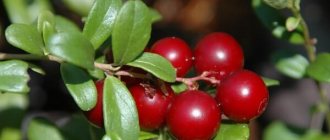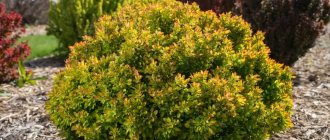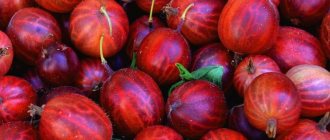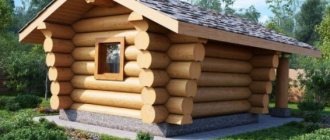Until now, I associate May with three plants: apple tree, lilac and viburnum. Soon, at the end of this month, the last bell will ring in schools, and teachers will receive luxurious May bouquets from grateful students.
Until now, I associate May with three plants: apple tree, lilac and viburnum. Soon, at the end of this month, the last bell will ring in schools, and teachers will receive luxurious May bouquets from grateful students. I remember that on this day the pupils always gave my mother lilacs and viburnum Buldonezh, the snow-white balls of which seemed unusually beautiful and almost fabulous to me, then a little girl.
On the southern coast of Crimea, the first viburnums bloom very early: from mid-December, but the peak of their snow-white, pink flowering occurs in May, so it was in this month, ignoring the time frame, that I tried to collect all the most interesting types of viburnums and talk about their decorative qualities and characteristics of cultivation. So, let's get acquainted.
Viburnum avabuki
The Japanese evergreen “stately” beauty - viburnum awabuki (Viburnum awabuki) comes from Japan and South Korea. It is tall, up to 4 m and long-lived. The leaves are large and shiny. The flowers are white, collected in loose, drooping inflorescences; bloom in May-June. It bears fruit regularly in September, but produces few viable seeds.
Features of cultivation
Relatively winter-hardy species. On the Black Sea coast of the Krasnodar Territory, during severe winters with an absolute minimum of -10-11°C, only the leaves are damaged to a greater or lesser extent. On the southern coast of Crimea, in cold winters, the ends of annual shoots freeze, with the loss of most of the leaves. Tolerates partial shade, but for abundant flowering it requires a sunny location and moderately moist, fertile, clay soils. Resistant to pests. Propagated by cuttings. A good plant for exotic groups and hedges.
Plant care
Plantings need care. This includes tilling the soil and applying fertilizers. It is also necessary to protect viburnum from pests and diseases.
In the first spring months, you need to loosen the soil around the trunk. To destroy the pests remaining after winter, it is necessary to treat viburnum bushes with fungicides. It is important to do this before the buds open, otherwise a burn may occur.
You can feed the tree with a 7% urea solution. In May, fertilizing is carried out with potassium fertilizer. After flowering, complex fertilizer is applied.
If pests appear, they must be destroyed. This can be done with environmentally friendly infusions. To prepare them, tobacco, potato tops, onion or garlic peels are used.
Viburnum should be watered regularly, especially in hot and dry weather. One bush requires approximately 3 buckets of water. Young seedlings require less moisture. It is better to water viburnum in the evening. We also loosen the soil and control weeds.
For preventive pest control, liquid fertilizer is applied to the soil in the fall. You need to dissolve 30 g of potassium sulfate and 30 g of superphosphate in 10 liters of water.
Barkwood Viburnum
Snow-white beauty (during flowering) - Barkwood viburnum (Viburnum x burkwoodii) is a garden hybrid of Carls viburnum and useful viburnum. It is a semi-evergreen shrub 2.5 m high and wide. The leaves are longitudinally wrinkled, up to 10 cm long. The flowers are pinkish-white, fragrant, in large umbellate inflorescences, up to 9 cm in diameter. Blooms in spring; fruits are rarely produced. Decorative forms are available.
Features of cultivation
Propagated by cuttings. Prefers light shade and well-drained, fertile soils. A good plant for small groups and close-in tapeworms.
Viburnum bodnant
A very difficult to pronounce species is bodnant viburnum (Viburnum x bodnantense), which, like the previous one, is a garden hybrid, but of fragrant viburnum and grandiflora viburnum. This is a deciduous shrub up to 3 m high, growing up to 2 m in width. Leaves are up to 10 cm long, young bronze. The flowers are light pink, collected in apical corymbs, up to 7 cm in diameter. Fruits are rarely set. There are decorative forms, the most interesting among them is 'Dawn' (dark pink flowers, collected in convex corymbose inflorescences, white when flowering).
Features of cultivation
Propagated by cuttings. Grows well in sunny places and in partial shade; prefers fertile, loose soil. Good in small groups in the background.
Planting viburnum in the country
Choosing a place to plant viburnum
In which place in the garden the viburnum will bloom is up to the owner to decide, as well as what function it will perform.
It could be:
- a single planted tree, a group of trees or a bush (viburnum grows in partial shade and shade, but feels best in an open sunny area);
- bushes acting as a fence (along the fence);
- bushes or trees planted on the slope of the site. In this case, the powerful root system of the plant is used, which can strengthen steep areas.
Nowadays it’s even difficult to imagine a summer cottage without at least one viburnum tree or bush. If someone has not acquired a fruit-bearing plant, then probably the charm of the ornamental variety forced them to plant this beautiful specimen, perhaps more than one, near their country house.
There is nothing difficult about planting. You just need to follow a few rules, as a result of which the seedling will turn into a lush bush or an exquisite tree. Viburnum is planted in spring or autumn.
Soil selection
Neutral or slightly acidic. The place and land are prepared in advance. Mix the soil well with peat and granular potassium phosphate fertilizer. This is done a month before planting the seedling. The soil will be significantly enriched and stable. You should not resort to organic fertilizer, as it provokes the growth of a large number of weeds, and they are the enemies of viburnum!
The planting hole is dug to a depth of about 40 cm, with the same diameter. To the soil you need to add a couple of tablespoons of urea and a glass of dolomite flour or ash. The top layer of soil, already enriched with peat, humus and fertilizers, will reliably cover the roots.
Planting a seedling with bare roots
Open roots: a small earthen mound is poured in the center of the hole, onto which the plant trunk is placed, and its roots are carefully and carefully spread along the walls of the mound, after which they are covered with the rest of the earth.
Planting a seedling with closed roots
Closed roots: the seedling is placed in the middle of the hole and covered with soil.
It is important not to forget to deepen the root collar a little, but no more than 4-5 centimeters!
After planting, compact the soil and mulch it with peat, then make a circular depression around the trunk and water the new plant generously.
Kalina Gordovina
Many people know the viburnum viburnum (Viburnum lantana). It is native to Europe, North Africa, and Southwest Asia. This is a deciduous shrub 2-4 m high. The leaves are rounded-ovate, up to 12 cm long. The flowers are creamy-white with a subtle pleasant aroma, collected in inflorescences - convex umbrella-shaped panicles, up to 10 cm in diameter; bloom in May. The fruits initially turn red and, as they ripen, acquire a blue-black color with a light coating. They are larger than the fruits of other types of viburnums, reaching a length of 12-15 mm. They ripen in September-October and are pecked very quickly by birds.
Features of cultivation
Viburnum is of medium growth rate, shade-tolerant, frost-resistant, can withstand frosts down to -23-25°C (at lower temperatures the leaves freeze). Tolerates saline soils, is drought-resistant, but grows better when watered. Blooms and fruits profusely in sufficiently moist, fertile, regularly cultivated soil. Known for its tolerance to a variety of conditions. Can be used for single and group planting in open areas and in partial shade. Slightly damaged by pests. Propagated by seeds, cuttings and layering. Seed germination lasts for 2 years. Before sowing, it is recommended to stratify the seeds at 5-10°C for up to 3 months. There is also information about possible thermal stratification at the same time. Seed placement depth is up to 3 cm. One of the most decorative shrubs with beautiful foliage, inflorescences and fruits, suitable for planting in summer cottages in tapeworms and groups.
Briefly about the history of appearance
Is sea buckthorn a tree or a shrub? Growing sea buckthorn at home
The use of viburnum in medicine and cooking goes back many centuries. In European herbalists, it has been mentioned as a medicinal plant since the 14th century, and in Ancient Rus', the juice of the fruit was used as an anticancer agent.
For your information! In the legends of different nations, the viburnum bush is mentioned as a symbol of love and beauty.
The selection of cultivated varieties followed the path of improving the properties of berries. Compared to wild ones, they have a sweeter taste. In ornamental gardening and landscape design, the Gordovina variety (Viburnum Lantana) is well known, whose fruits are inedible, but the flowering and crown are very beautiful. The buldenezh species does not bear fruit, but within a month it pleases the eye with huge snow-white inflorescences. Among the sweet-fruited varieties, the most famous for this characteristic is Red Coral.
Kalina David
Chinese evergreen beauty - David's viburnum (Viburnum davidii); homeland: Western China. This is a compact, squat shrub, 1-1.5 m high and wide. The leaves are like those of a plantain, up to 15 cm long. The flowers are white, in sparse, corymbose inflorescences; bloom in late spring. Rarely bears fruit.
Features of cultivation
Propagated by cuttings. Prefers shady places with moderately moist and fertile soil. An original plant for shady gardens.
Pest protection
The bush should be regularly inspected for timely detection of pests. Viburnum can be bothered by aphids. This “scourge” settles in the apical shoots and feeds on young foliage. In order to protect against aphids in the future, it is recommended to cut off all shoots by 15 cm in the spring. In the summer season, the trunk of the viburnum should be wrapped with adhesive tape (which is used to catch flies). This will protect the bush from ants, which deliver their prey - aphids - to the bush.
If such measures do not bring results, insecticides will have to be used. These include modern drugs “Fitoverm”, “Intavir”, “Bitoxibacillin”, etc.
The red viburnum bush is shade-tolerant, so it can be planted almost anywhere in the garden. The plant looks attractive throughout the year. Fruiting occurs in the second year of life. Even with little care, this plant will transform the garden and provide many years of useful pleasure.
Viburnum fragrant
And again, the eastern viburnum is the fragrant viburnum (Viburnum odoratissimum) native to the Southeast Himalayas and Central China. This is a large evergreen shrub, up to 5 m high and wide. The leaves are thick, glossy, elongated oval, up to 20 cm long. The flowers are white, fragrant, collected in round racemes, 8-10 cm long. Red fruits are rarely formed.
Features of cultivation
Low winter hardiness: can withstand temperatures down to -5 degrees C. Propagated by cuttings. Prefers shaded locations with moist, fertile, clayey, acidic soils. A beautiful plant for small groups and as a tapeworm under the canopy of tall trees.
Kalina Karlsa
Eastern beauty - Carl's viburnum (Viburnum carlesii); homeland: Korea, Japan. A small deciduous shrub up to 2 m high and wide. The leaves are ovate-oval, wrinkled. The flowers are white, as if sculpted from wax, collected in sparse corymbose inflorescences, with a very delicate scent; They bloom before the leaves bloom, in April-May. Fruits are rarely produced. There are decorative forms, the most decorative being 'Aurora' (the bush is more compact, the flowers are pale pink). The fruits are blue-black drupes that ripen in September-October.
Features of cultivation
In Eastern Europe, where Karls viburnum is widely used in landscape design, it tolerates frosts down to -30°C. Prized for its fragrant pink flowers in early spring, orange-red leaves and blue-black fruits in autumn. Good for solitary and group plantings. It is not demanding on lighting conditions, but the most luxuriant flowering is observed in partial shade, on fertile, well-drained soils. Propagates well by grafting on the crown, by seeds and cuttings. Sowing in autumn after harvesting or in spring with stratification. Without it, the emergence of seedlings is delayed up to 2 years. Resistant to pests.
Description
Where does viburnum grow?
Photo of viburnum bush:
Viburnum grows in natural conditions in the form of a small tree or shrub. Viburnum shrub reaches a height of 4 meters. The bark is gray with a brown tint. Longitudinal cracks are clearly visible on it. Viburnum leaves:
- petiolate
- entire or jagged
- whole, lobed or palmate-lobed
- simple
- falling
- opposite, sometimes whorled.
Viburnum leaves photo in the picture:
What does viburnum look like?
The inflorescences are a set of heteromorphic flowers of white or pink color, have an umbrella shape and are located on the tops of young branches. The flowering period is as follows: the last ten days of May – the first days of June. Viburnum berries are drupes with a bright red shell, oval or spherical in shape, reaching no more than 10 mm in diameter, on average 8 mm. Their ripening period: late August – mid-September.
Viburnum berry photo:
Viburnum cinnamon-leaved
Another Chinese viburnum is the cinnamon-leaved viburnum (Viburnum cinnamomifolium), native to Western China. This is an evergreen shrub with a loose and at the same time columnar crown. The leaves are not typical for viburnums, they are more like the leaves of cinnamon trees: oval-pointed, bent along the central vein, serrated, with arcuate veins, shiny, brownish-green in color. The flowers are inconspicuous, fruits are rarely produced.
Features of cultivation
Not winter-hardy: can withstand temperatures down to -5 degrees C. Propagated by cuttings. It is undemanding to light conditions and needs acidic soils. A unique plant for complex groups.
Viburnum large-headed
Very spectacular during the flowering period, large-headed viburnum (Viburnum macrocephalum) is a semi-evergreen or deciduous shrub up to 5 m high and wide. It is a garden hybrid. The leaves are ovate-oval, up to 10 cm long. The flowers are white, sterile (not setting fruit), collected in large, spherical inflorescences, up to 15 cm in diameter! The inflorescences are similar to those of the common viburnum 'Pink'; the same greenish at the beginning of flowering and turning pink when flowering fades.
Features of cultivation
Low winter hardiness: can withstand temperatures down to -5 degrees C. Propagated by cuttings, but poorly. Prefers light shade and moist, fertile, acidic soils. An impressive plant as a tapeworm and for small groups.
Reproduction methods
There are three ways to propagate viburnum Buldenezh.
Cuttings
A young shoot with several dormant buds is used as planting material. After the viburnum blooms, the shoot is cut off and placed in a growth stimulator for 7-8 hours.
The cutting is planted in a hole with nutritious soil and covered with a plastic bottle or jar to create a greenhouse microclimate. Water moderately. When leaves appear, the covering material is removed. Over the summer, the young seedling will grow stronger, grow roots, and overwinter without any problems. It is transplanted to a permanent place in the spring.
By layering
Select a young shoot growing close to the ground, bend it to the ground, placing it in the prepared groove. Pin with wire, sprinkle with fertile soil. Irrigate regularly with water. Separate the young seedling from the mother plant after rooting.
Dividing the bush
A strong, developed stem is separated from an overgrown bush with a sharp shovel and planted in a new place. You can dig up the entire bush and divide it into two or three parts. Sprinkle the cut areas with charcoal.
Propagation of viburnum by seeds is impossible; the flowers of the sterile variety Buldenezh do not have a pistil or stamens.
Laurel leaf viburnum, or evergreen
The Mediterranean beauty is the laurel viburnum (Viburnum tinus), which blooms on the Black Sea coast of the Krasnodar Territory and the southern coast of Crimea from winter to early spring. It is interesting that the ancient Romans used the Latin word tinus to name many plants whose leaves were similar to those of laurel. It is an evergreen shrub, 1-3 m high. The leaves are leathery, sparsely and rigidly pubescent, pointed-oval. The flowers are white, sometimes with a pinkish tint, collected in flat, corymbose inflorescences, 5-10 cm in diameter, which appear on normally developed plants almost all year round, but the most abundant flowering is observed in winter. Viburnum laurel is one of the most common and most resistant winter flowers not only in the Sochi region, but also in Yalta. The fruits are oval-pointed, pearl-blue, and are always produced in abundance, and in the summer this species is a spectacular, beautifully fruited shrub. Decorative forms are available.
Features of cultivation
At a temperature of -15°C it freezes a lot. Tolerates drought well. Propagated by seeds (autumn sowing) or stratified seeds in spring, as well as green cuttings (under glass) and layering. Grows well in light shade, on fertile, loose, neutral soils. It withstands pruning well, is perfectly shaped and used in topiary art. Can be used for solitary and group plantings, borders and low hedges. In some years it is severely damaged by the viburnum whitefly, seaside mealybugs and viburnum bugs.
How to care
The aristocratic viburnum Buldenezh is hardy and undemanding in care. It is especially popular among gardeners. The frost-resistant perennial is grown in various regions of our country; viburnum has taken root even in Siberia and the Urals. Simple rules for planting and caring will help even beginners in gardening to grow ornamental shrubs.
Soil selection
Soil fertility is the key to abundant flowering of viburnum. Soil acidity should not be higher than 6.5. If the indicator is higher, the soil substrate must be treated with a lime solution. Ground ventilation should be ensured. To do this, it is enough to periodically loosen the top soil layer. When planting crops in heavy, dense soil, it is recommended to add sand.
Location and lighting
The perennial flowering shrub prefers to grow in a lighted area. A little shading will not affect the flowering of the plant. The ideal place for planting is near the wall of the house, fence, next to the gazebo. Viburnum does not like to grow on a hill; a slope or lowland without stagnant water is preferable for it.
If it is possible to plant viburnum near a pond, then this should definitely be done. For a moisture-loving culture, such a neighborhood is the most favorable. An important condition for this is the laying of a drainage layer in the planting hole, which will prevent water stagnation.
Temperature, humidity, watering
The frequency of watering depends on the age of the plant and weather conditions. During the rainy summer, viburnum will receive enough natural moisture. In dry summers, watering should be regular and abundant. An adult bush is watered 2-3 times a month (water volume - 50 liters), a young one - 2-3 times a week (two buckets of water). Watering is carried out in the evening with warm water; you can place containers to heat the water in the sun.
Mulching will protect the soil from drying out: mix sawdust and peat, and cover the surface around the viburnum with the resulting mixture.
In the absence of rain in autumn, Buldenezh also needs watering; the moisture will protect the bush from dehydration.
Fertilizers and fertilizers
For the full development of the crop, fertilizing should not be neglected. Depending on the fertility of the soil there may be one or two.
In the spring, before flowering, it is recommended to apply complex fertilizer for ornamental plants. The mineral composition is applied in dissolved or dry form to the root area. When applied dry, the soil around the plant is loosened and watered abundantly.
You can prepare your own nutritional mixture. For this you will need superphosphate (40 g), ammonium nitrate (25 g), potassium salt (15 g), compost (6-7 kg). The specified ratio of substances in the composition is used to feed one bush.
It is enough to saturate the nutrient soil with organic matter: infuse one part of chicken manure in 10 parts of water. You can prepare an infusion of herbs, which must first be fermented. Water at the root. Humus or wood ash is also suitable as a top dressing.
Transfer
It is not recommended to replant Viburnum Buldenezh before it has grown for two years in its previous location. In two years, the bush will take root and grow a root system, which will facilitate growth in the newly selected area.
Transplantation is done in early autumn or spring. The stages of transplantation are the same as when planting seedlings.
- Dig a planting hole. It should be spacious, since lateral roots quickly develop from the central root. Minimum hole size: depth 60 cm, width 70 cm.
- Place drainage at the bottom. They use tree bark (chopped into pieces), expanded clay, and small crushed stone. Drainage will prevent stagnation of water, which the viburnum root system does not tolerate well.
- Pour about 30 kg of humus onto the drainage. Mix the compost with phosphorus fertilizer, wood ash, they are also added to the hole. If the soil is heavy, it is diluted with coarse sand.
- Pour 2 buckets of water into the hole. After most of the water has been absorbed, the seedling is placed in the mud. All the roots are covered with earth, leaving no voids around them. The seedling should be at the same height as it grew previously.
- Carefully cover the seedling with the remaining soil and compact it. Water again.
- It is recommended to mulch the tree trunk circle with sawdust or humus.
Trimming
Viburnum Buldenezh needs annual pruning. Each stage of plant development must be accompanied by certain manipulations:
- All unopened inflorescences are removed from a one-year-old seedling. At the end of summer, young shoots are partially pinched so that the crown is formed lush;
- In a two-year-old bush, shoots located below 20 cm from the soil are pruned;
- Every year in the spring (before flowering), damaged branches are cut out - dried, broken, weakened;
- the crown is formed after flowering, when the plant has reached a height of 1.5 meters. It can be shaped into a ball, triangle, or standard.
Pruning is carried out until mid-summer so that the viburnum regains its strength before winter.
Winter care
Before frost, viburnum needs to be watered and fed with organic fertilizers. It is not recommended to apply fresh manure.
Mature plants do not need shelter. The tree trunk soil around young bushes should be mulched with compost. Additionally, “insulate” with sawdust or pine needles.
Viburnum rugosafolia
Another Chinese evergreen beauty is wrinkled viburnum (Viburnum rhytidophyllum), native to Central and Western China. This is a tall shrub (3-5 m), growing up to 4 m in width, with a rather loose, sparse crown. The leaves are large, up to 20 cm long, drooping, with an interesting relief-wrinkled structure. The flowers are small, creamy-white, collected in loose, flattened inflorescences, up to 20 cm in diameter; they are decorative and in the bud stage; bloom in April-May. The blackish-purple fruits set well.
Features of cultivation
Requires moderately moist soils or normal watering during the growth period, semi-shade, protected from drying winds, location, neutral soils. It is the most frost-resistant of all evergreen viburnums. Easily propagated by seeds and vegetatively (cuttings). Effective in single and group plantings. Slightly damaged by pests.
Viburnum common
The very famous viburnum viburnum (Viburnum opulus) comes from Eurasia. This is a spreading deciduous shrub up to 5 m high, up to 4 m wide. The leaves are spatulate, large, up to 10 cm long. The flowers are white, in flat inflorescences, the marginal flowers of which are sterile, with relatively large, white petals. The fruits are juicy red berries in loose, flattened clusters; touched by frost, they are edible with a unique taste and aroma.
Features of cultivation
Shade-tolerant, moisture-loving, prefers fertile, moist soils, but also grows on fairly dry loamy soils. On the southern coast of Crimea it suffers somewhat from drought, but blooms and bears fruit satisfactorily. Quite durable: lives up to 50 years or more. Propagated by seeds, root suckers, cuttings. When sowing in autumn with freshly harvested seeds, seedlings appear after 1.5 years. For spring sowing, 6 months of stratification in wet sand at a temperature of about 5°C is required. Seeds are planted to a depth of 2.5-3 cm. Germination varies from 40-90%. It develops normally only on constantly moist, fertile soils, in well-lit places. A beautiful, traditionally favorite ornamental shrub for single and group plantings. Its decorative form 'Roseum' is very impressive - a form with completely sterile flowers in spherical inflorescences, 5-6 cm in diameter, which are initially greenish in color, then become white and pinkish when they bloom.
That is why its scientific name is 'Pink', while in common parlance it is often called 'Bulldonezh' - a corruption of the French name 'Snow Globe'. This form is less demanding on soil moisture and light levels. Luxurious viburnum for solitary and group plantings. Severely damaged by black viburnum aphid and roseate leaf roller. Suitable for planting on hills in groups or tapeworms. The formed standard specimens are very good.
Viburnum is useful
Viburnum utile (Viburnum utile) is native to Central China. It is an evergreen shrub, up to 1.5 m high. The leaves are elliptical-ovate, 2-7 cm long. The flowers are white, fragrant, collected in dense stellate-pubescent corymbs, 5-8 cm in diameter; bloom in April-May. The fruits are bluish-black.
Features of cultivation
Prefers a semi-shaded location and requires improved local soil conditions and watering in the summer. It does not tolerate a lack of soil moisture, especially in a sunny location: in such cases, shedding of leaves is observed. Suitable for planting along walls, borders and in groups. It is practically not damaged by pests.
Features of yellow-fruited viburnum berries
Externally, the common red and yellow viburnum are distinguished ONLY by the color of the berries and the autumn color of the foliage : the leaves of the common viburnum become red in the fall, while those of the golden viburnum are yellow and do not fall off for a long time.
The chemical composition of the berries and the taste of yellow-fruited viburnum and red viburnum are practically the same. The only yellow berries are safer for allergy sufferers than red ones.
Viburnum contains quite a lot of vitamins (carotene, vitamins C, P, group B). A mixture of viburnum juice and honey is an excellent remedy for autumn blues and colds.
Viburnum folded
East Asian beauty - folded viburnum (Viburnum plicatum), homeland - China, Japan, Taiwan. It is a deciduous shrub with arched drooping branches, 3 m high and 4 m wide. The leaves are ovate-oval, with folded leaves. The inflorescences are very similar to the inflorescences of the common viburnum, but they are located on the branches in pairs along the entire length of the shoots, which is why this viburnum is very elegant during flowering. Rarely produces fruits. Decorative forms are available.
Features of cultivation
Propagated by cuttings. This viburnum is not demanding on growing conditions, but the most lush bushes are obtained when planted in lighted areas with fertile, well-drained soil. A beautiful plant for tapeworms and groups.
Trimming
Proper pruning helps to form a healthy plant and produce large yields of berries.
Sanitary
After a frosty winter, sanitary pruning is carried out.
At the same time, all frozen and dried shoots, as well as branches with signs of various diseases, are removed.
Thinning
Thinning pruning involves removing thickened areas and trimming improperly formed branches.
Formative
Every spring, strong shoots are shortened to stimulate the development of lateral shoots.
Rejuvenating
Anti-aging pruning is carried out no more than once every five years. In this case, all old branches are removed, leaving about 20 of the strongest shoots. It is better to cut off weakly flowering bushes completely at a height of 30 cm from the root collar.
Viburnum Farrera, or fragrant
Chinese fragrant beauty - Farrera viburnum (Viburnum farreri, syn.V. fragrans), homeland: Northern China. It is a deciduous shrub, up to 3 m high and up to 2.5 m wide. The leaves are elliptical, up to 10 cm long. The flowers are from white to pink, fragrant, collected in inflorescences, up to 5 cm in diameter; bloom in winter and early spring.
Features of cultivation
It is quite winter-hardy: it can withstand temperatures down to -15 degrees C. It is undemanding under cultural conditions. Slightly damaged by pests. Suitable for single planting and in groups. For rejuvenation, all old branches are cut at a level of 15-20 cm from the soil surface. Propagated by seeds, layering and cuttings, both green and woody.
Diseases and pests
Timely thinning of the viburnum bush is an effective preventive measure against diseases and pests.
Rainy weather often causes perennial disease. Preventive spraying of ornamental crops with tobacco or garlic-onion solution will protect it from diseases such as powdery mildew, spotting and gray rot. If the disease is detected, treatment with special preparations is necessary: “Hom”, “Abiga-Pik” and others.
Insect pests also pose a threat: black aphids, viburnum leaf beetles, cap moths, and scale insects. Two or three times treatment (with a ten-day interval) with insecticides (Inta-Vir, Karbofos, Iskra, Fufanon) will help destroy uninvited guests.
A few facts about viburnums that you didn’t know yet:
- Have you noticed that viburnum leaves are shaped like maple leaves? Hence the Latin name of the genus Viburnum - the Roman designation for common maple, which emphasizes the external similarity of the leaves of these two plants.
- Viburnum seeds germinate only after a year during autumn and spring sowing, so late summer sowing from mid-August is recommended.
- Most viburnums have edible fruits; they contain a significant amount of organic acids, vitamins and about 15 different chemical elements that are valuable for the human body.
- The bark, leaves, flowers and fruits of some types of viburnums have long been widely used in medicine.
- Viburnums are decorative, dust- and gas-resistant, some species can withstand drought and soil salinity, and tolerate pruning of branches well, allowing the formation of various types of crowns. They have a high restorative ability, so they are used to create roadside snow collection strips in shelter forestry, to stabilize soils on mountain slopes and as undergrowth to attract birds to plantings.
Varieties for gardeners
Gone are the days when “just viburnum” grew on the plot. Thanks to the work of scientists, it became possible to purchase and grow special varieties that meet the requirements of gardeners. Some people focus on the decorative nature of the plant and do not care about the number of berries in the fall; for others, on the contrary, it is important to get a harvest in order to start harvesting fruits for the winter.
In folk medicine, viburnum is used as a general tonic, which is facilitated by the high content of vitamin C, and also to relieve fever. In addition, diuretic and laxative effects from eating berries have been observed. Fruit juice lowers blood pressure. In reasonable portions, it improves digestion.
